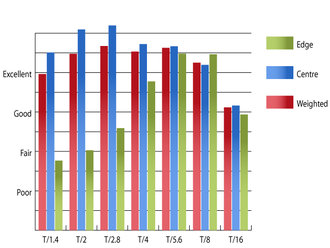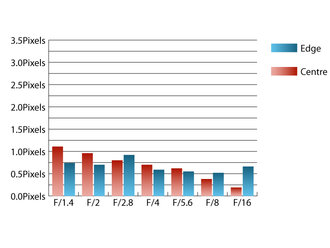SLR Magic 35mm T/1.4 Cine Mark II Lens Review
SLR Magic 35mm T/1.4 Cine Mark II Lens Performance
Reading the description of this lens on the SLR Magic website, you'd be forgiven for expecting this lens to perform poorly, as far as sharpness is concerned. In the centre of the image area, sharpness is excellent from maximum aperture. Towards the edges of the frame, there is a gradual vignette of softness at fast apertures, with sharpness reaching very good levels here as the lens is stopped down to T/4 or beyond.  Resolution at 35mm | How to read our chartsThe blue column represents readings from the centre of the picture frame at the various apertures and the green is from the edges. Averaging them out gives the red weighted column. The scale on the left side is an indication of actual image resolution. The taller the column, the better the lens performance. Simple. For this review, the lens was tested on a Panasonic Lumix G3 using Imatest. |
Chromatic aberrations are a little high across the frame at fast apertures, exceeding one pixel width at T/1.4. The amount of fringing present is reduced to acceptable levels as the aperture is stopped down to T/4 or beyond.
 Chromatic aberration at 35mm | How to read our chartsChromatic aberration is the lens' inability to focus on the sensor or film all colours of visible light at the same point. Severe chromatic aberration gives a noticeable fringing or a halo effect around sharp edges within the picture. It can be cured in software.Apochromatic lenses have special lens elements aspheric, extra-low dispersion etc. to minimize the problem, hence they usually cost more. For this review, the lens was tested on a Panasonic Lumix G3 using Imatest. |
Falloff of illumination towards the corners is very well controlled for a lens with such a fast maximum aperture. At maximum aperture, the corners are 0.95 stops darker than the image centre and illumination is visually uniform by T/2.8.
Imatest detected 1.14% barrel distortion, which is fairly typical for a standard lens with a fast maximum aperture. The distortion pattern is uniform across the frame, so applying corrections in image editing software should be relatively straightforward.
Contrast is pretty good with this lens, although shooting into the light at fast apertures will result in a loss of contrast similar to what you might expect from vintage lenses with weak anti-reflective coatings. The look it produces in these conditions is an acquired taste, that may not be everyone’s cup of tea.
Add your message
Login required
Please login here or if you've not registered, you can register here. Registering is safe, quick and free.
Please login here or if you've not registered, you can register here. Registering is safe, quick and free.
photodo Stats
1102 lenses
428 MTF tests
74 in-depth photodo reviews
100+ users join each day
Help the lens community by reviewing or rating a lens today via our lens search
428 MTF tests
74 in-depth photodo reviews
100+ users join each day
Help the lens community by reviewing or rating a lens today via our lens search
Latest Lens Reviews
- Chinon 28mm f/2.8 Vintage Lens Review
- Canon EF 70-200mm f/4L IS II USM Lens Review
- Samyang AF 85mm f/1.4 EF Review
- Sigma 70mm f/2.8 DG Macro Art Review
- Samyang AF 24mm f/2.8 FE Review
- Meike 50mm f/1.7 Review
- Tamron 70-210mm f/4 Di VC USD Review
- Lensbaby Burnside 35mm f/2.8 Review
- Asahi Super Takumar 50mm f/1.4 Review
- Asahi Super-Multi-Coated Takumar 135mm f/3.5 Review
